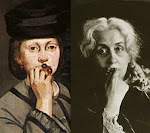
"Ribands occur frequently in arabesques,--in some of a high order, too,--tying up flowers, or flitting in and out among the fixed forms. Is there anything like ribands in nature? It might be thought that grass and seaweed afforded apologetic types. They do not. There is a wide difference between their structure and that of a riband. They have a skeleton, an anatomy, a central rib, or fibre, or framework of some kind or another, which has a beginning and an end, a root and head, and whose make and strength affect every direction of their motion, and every line of their form. The loosest weed that drifts and waves under the heaving of the sea, or hangs heavily on the brown and slippery shore, has a marked strength, structure, elasticity, gradation of substance; its extremities are more finely fibred than its centre, its centre than its root: every fork of its ramification is measured and proportioned; every wave of its languid lines is lovely. It has its allotted size, and place, and function; it is a specific creature. What is there like this in a riband? It has no structure: it is a succession of cut threads all alike; it has no skeleton, no make, no form, no size, no will of its own. You cut it and crush it into what you will. It has no strength, no languor. It cannot fall into a single graceful form. It cannot wave, in the true sense, but only flutter: it cannot bend, in the true sense, but only turn and be wrinkled. It is a vile thing; it spoils all that is near its wretched film of an existence. Never use it."
(From: John Ruskin, "The Lamp of Beauty", The Seven Lamps of Architecture, (Leipzig: Bernhard Tauchnitz, 1907), 155. (Reprint of the revised English 1880 edition).


No comments:
Post a Comment